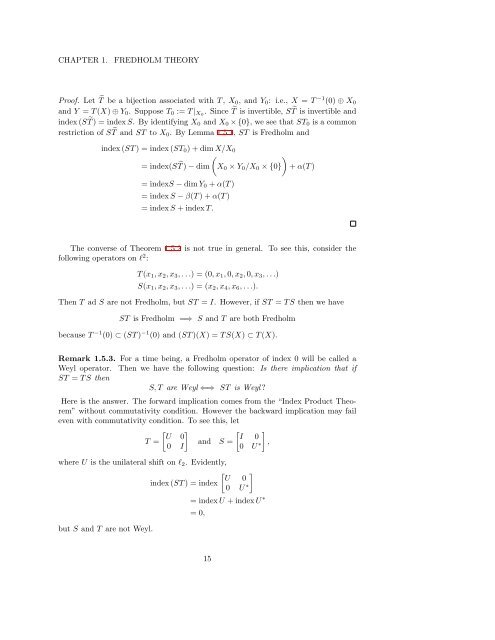Woo Young Lee Lecture Notes on Operator Theory
Woo Young Lee Lecture Notes on Operator Theory
Woo Young Lee Lecture Notes on Operator Theory
Create successful ePaper yourself
Turn your PDF publications into a flip-book with our unique Google optimized e-Paper software.
CHAPTER 1.<br />
FREDHOLM THEORY<br />
Proof. Let ˜T be a bijecti<strong>on</strong> associated with T , X 0 , and Y 0 : i.e., X = T −1 (0) ⊕ X 0<br />
and Y = T (X) ⊕ Y 0 . Suppose T 0 := T | X0 . Since ˜T is invertible, S ˜T is invertible and<br />
index (S ˜T ) = index S. By identifying X 0 and X 0 × {0}, we see that ST 0 is a comm<strong>on</strong><br />
restricti<strong>on</strong> of S ˜T and ST to X 0 . By Lemma 1.5.1, ST is Fredholm and<br />
index (ST ) = index (ST 0 ) + dim X/X 0<br />
(<br />
)<br />
= index(S ˜T ) − dim X 0 × Y 0 /X 0 × {0} + α(T )<br />
= indexS − dim Y 0 + α(T )<br />
= index S − β(T ) + α(T )<br />
= index S + index T.<br />
The c<strong>on</strong>verse of Theorem 1.5.2 is not true in general. To see this, c<strong>on</strong>sider the<br />
following operators <strong>on</strong> l 2 :<br />
T (x 1 , x 2 , x 3 , . . .) = (0, x 1 , 0, x 2 , 0, x 3 , . . .)<br />
S(x 1 , x 2 , x 3 , . . .) = (x 2 , x 4 , x 6 , . . .).<br />
Then T ad S are not Fredholm, but ST = I. However, if ST = T S then we have<br />
ST is Fredholm =⇒ S and T are both Fredholm<br />
because T −1 (0) ⊂ (ST ) −1 (0) and (ST )(X) = T S(X) ⊂ T (X).<br />
Remark 1.5.3. For a time being, a Fredholm operator of index 0 will be called a<br />
Weyl operator. Then we have the following questi<strong>on</strong>: Is there implicati<strong>on</strong> that if<br />
ST = T S then<br />
S, T are Weyl ⇐⇒ ST is Weyl <br />
Here is the answer. The forward implicati<strong>on</strong> comes from the “Index Product Theorem”<br />
without commutativity c<strong>on</strong>diti<strong>on</strong>. However the backward implicati<strong>on</strong> may fail<br />
even with commutativity c<strong>on</strong>diti<strong>on</strong>. To see this, let<br />
T =<br />
[ U 0<br />
0 I<br />
]<br />
and S =<br />
[ ] I 0<br />
0 U ∗ ,<br />
where U is the unilateral shift <strong>on</strong> l 2 . Evidently,<br />
[ ] U 0<br />
index (ST ) = index<br />
0 U ∗<br />
but S and T are not Weyl.<br />
= index U + index U ∗<br />
= 0,<br />
15













